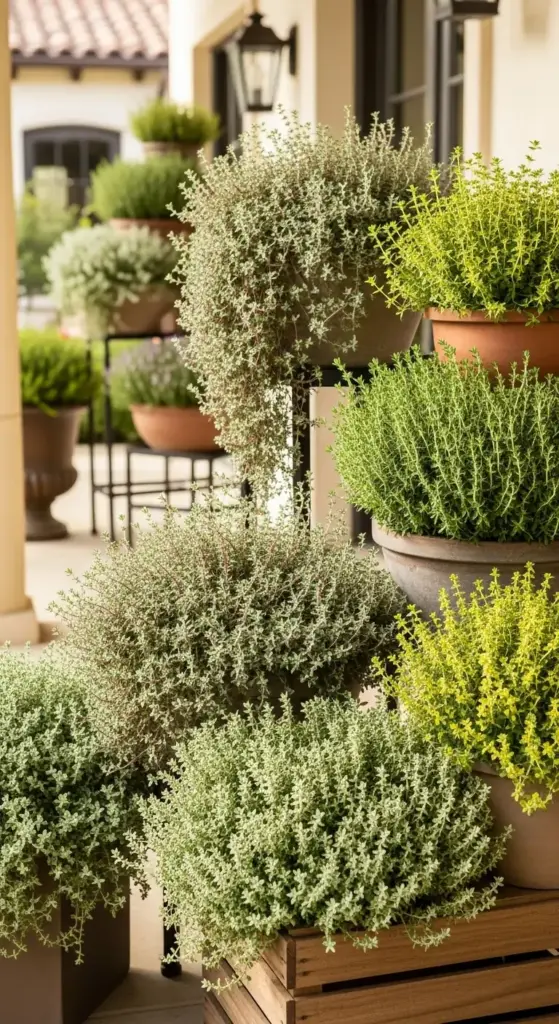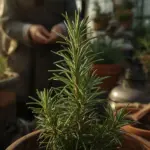5. Thyme: The Delicate Millionaire’s Touch

I’ll never forget the moment I realized thyme was the secret ingredient missing from my herb containers. One tiny plant transformed my entire porch display from “nice hobby garden” to “did you hire a landscape designer?”
It’s those impossibly small leaves and delicate texture that create instant sophistication – like adding jewelry to an outfit.
Why Thyme Screams Subtle Elegance
Here’s what I love about thyme – it’s the herb equivalent of that perfectly tailored blazer that makes everything else look more expensive.
Those tiny, needle-like leaves create this incredible fine texture that makes other herbs look more dramatic by contrast. It’s like having a neutral backdrop that makes everything else pop.
The fragrance is pure sophistication too. Not overwhelming like some herbs, but this subtle, earthy scent that whispers “expensive garden” instead of shouting it.
I learned this when I added creeping thyme to a container with bold basil and rosemary. Suddenly the whole arrangement looked balanced and intentional instead of just “a bunch of herbs in a pot.”
The visual impact is all about scale and texture. Thyme creates these beautiful carpets of tiny leaves that look like living mulch – but way more elegant than any decorative stone could ever be.
Ground-Covering vs. Upright: Choosing Your Design Effect
This is where I made my first big mistake – I didn’t realize there were completely different growth habits until I planted the wrong type for my vision.
Creeping thyme varieties like ‘Elfin’ or ‘Red Creeping’ are absolute magic for cascading effects. They spill over container edges like a living waterfall, creating that expensive “established garden” look in just one season.
I use these as my “spillers” in container combinations – they soften hard edges and make everything look more natural and mature.
Upright thyme varieties like ‘French’ or ‘English’ create completely different effects. They form these neat little mounds that add structure and height variation to arrangements.
My biggest design breakthrough? Combining both types in the same large container. Upright thyme in the center for structure, creeping varieties around the edges for that cascading luxury effect.
Lemon thyme deserves special mention – it’s upright but with this gorgeous golden-green foliage that adds color interest. Plus, the citrus scent is incredible when you brush against it.
Creating Those Instagram-Worthy Cascading Displays
This is where thyme really shines and where I learned to think like those fancy garden designers I follow on social media.
Elevated planters are thyme’s best friend. I use plant stands, overturned pots, or even stacked wooden crates to get my thyme containers up high. The cascading effect is so much more dramatic when it has room to flow.
The secret is patience and proper spacing. I plant creeping thyme about 6 inches apart and let it fill in naturally. Trying to rush it by overcrowding just creates a messy look.
Tiered arrangements work beautifully – I use three different heights with trailing thyme in the highest container, medium herbs in the middle, and taller structural plants at ground level.
I discovered that mixing different creeping thyme varieties creates incredible visual interest. Red creeping thyme with its burgundy stems, silver thyme with variegated leaves, and regular green creeping thyme together look like an expensive living tapestry.
Companion Plants That Enhance Thyme’s Beauty
Here’s where I learned that thyme is the ultimate team player – it makes everything else look better while looking gorgeous itself.
Lavender and thyme are a match made in heaven. The fine texture of thyme against lavender’s silvery spikes creates this sophisticated Mediterranean vibe that screams expensive taste.
Silver-leafed plants are thyme’s best friends. Dusty miller, silver sage, or artemisia create this cohesive color palette that looks professionally designed. The fine textures complement each other beautifully.
Small ornamental grasses like fountain grass or blue fescue add movement and height while maintaining that delicate, refined aesthetic. I learned this from studying high-end landscape photos.
I also discovered that small succulents pair surprisingly well with thyme. Hens and chicks or small sedums create interesting textural contrast while sharing similar care requirements.
Pro tip: Avoid pairing thyme with large-leafed plants like basil in the same container. The scale difference looks awkward instead of intentional.
Seasonal Care for That Pristine Look
This is where I learned the difference between growing thyme and maintaining beautiful thyme that looks expensive year-round.
Spring is pruning time. I lightly trim back any woody stems and shape the plants before new growth starts. This keeps them looking neat and encourages fresh, tender growth.
Summer maintenance is all about deadheading. Thyme flowers are pretty, but removing them keeps the foliage looking fresh and prevents the plant from getting leggy.
Fall preparation is crucial for maintaining that pristine appearance. I cut back about one-third of the growth and add a light layer of decorative mulch around the base.
Winter care varies by variety, but most thymes are surprisingly hardy. I learned to resist the urge to overwater during dormant periods – soggy soil is thyme’s biggest enemy.
The secret to year-round beauty: Regular light harvesting keeps plants bushy and full. I snip sprigs for cooking at least once a week during growing season.
Cost-Effective Strategies Under $35
Here’s exactly what I spent on my most successful thyme display setup:
Cascading Container Garden:
- Three thyme varieties (creeping and upright): $15
- Elevated planter with drainage: $12
- Quality herb potting mix: $6
- Decorative stone mulch: $3
- Total: $36 for a professional-looking display
But here’s my money-saving secret – thyme is incredibly easy to propagate through division and cuttings.
Free multiplication method: In spring, carefully divide established clumps. Each piece with roots becomes a new plant. I’ve turned one $5 thyme plant into six plants this way.
Cutting propagation works too – take 3-inch cuttings in early summer, strip lower leaves, and root in water or moist soil. Success rate is about 80% in my experience.
Budget container ideas that look expensive:
- Shallow terracotta saucers ($3 each) – perfect for creeping thyme
- Repurposed wooden boxes lined with landscape fabric
- Thrift store ceramic bowls with drainage holes drilled
I learned to start small and let thyme fill in naturally. One small plant in a 12-inch container looks sparse initially but creates a full, lush display by mid-season.
Timing purchases for maximum savings: Buy thyme plants in late summer when nurseries are clearing inventory. I’ve scored healthy plants for $2-3 each during end-of-season sales.
The ongoing value is incredible – fresh thyme for cooking, natural ground cover that suppresses weeds, and that constant sophisticated texture that makes every other plant look more expensive.
Plus, established thyme plants are practically maintenance-free once they’re settled in. It’s like having a living mulch that actually improves your garden’s appearance instead of just covering soil.
Ready to bring some Mediterranean mansion vibes to your herb collection? Click “next” to discover Oregano: The Mediterranean Mansion Vibe – the herb that creates that expensive, sun-soaked Italian garden aesthetic while being one of the most budget-friendly and low-maintenance options in your arsenal!








GIPHY App Key not set. Please check settings